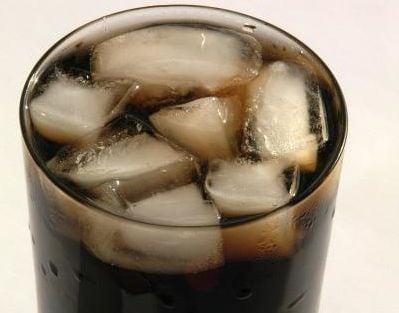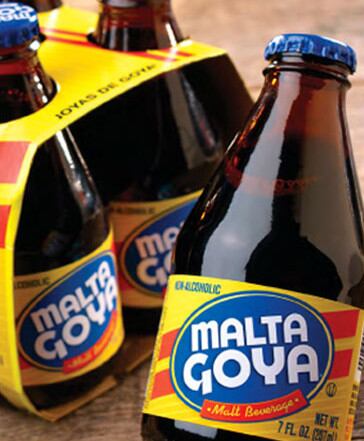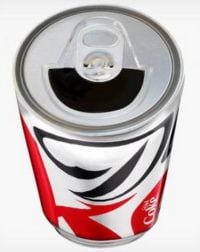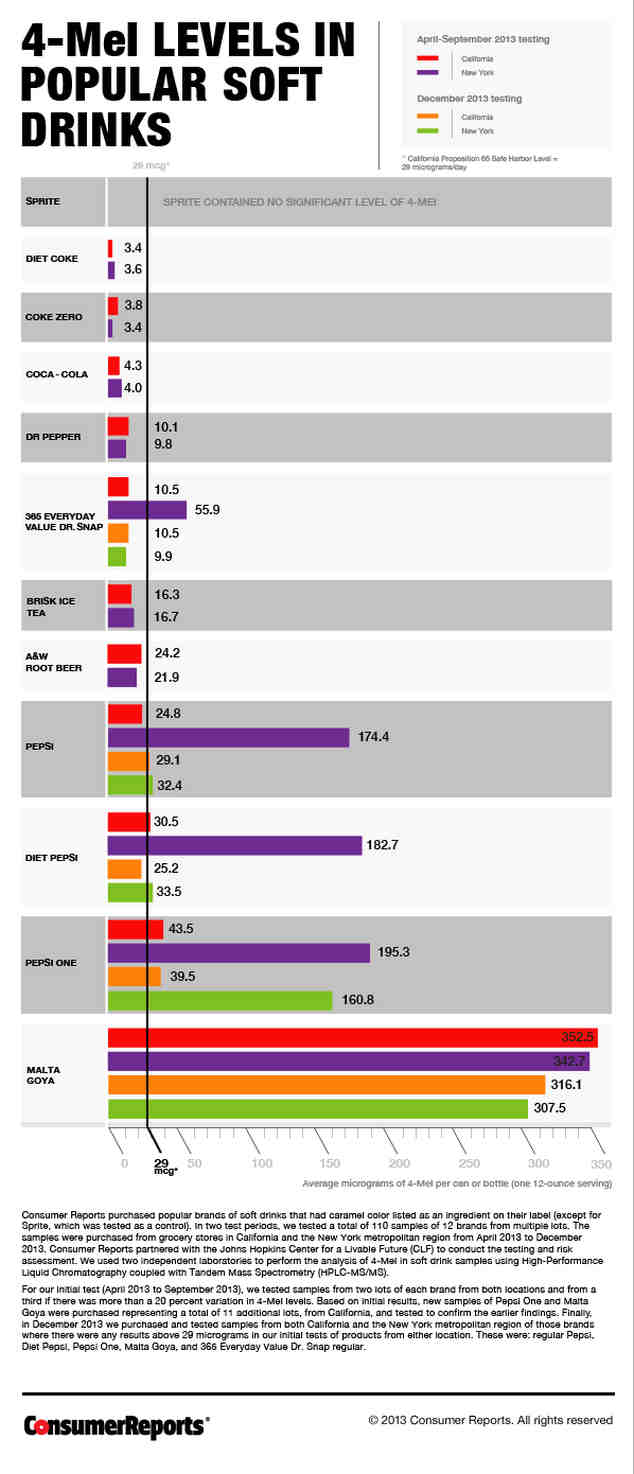Its comments came as product testing firm Consumer Reports published results of tests* showing what it claimed to be “concerning” levels of 4-MeI (4-Methylimidazole) in soft drinks and called on the FDA to set federal limits well below those already enshrined in California’s Proposition 65 list.
Toxicologist: 4-MeI federal limit should be set at 3 micrograms/day
According to Consumer Reports, tests of leading soft drinks brands throughout 2013 showed a wide variation in 4-MeI levels, with some well in excess of the Prop 65 safe harbor levels, others well below, and some containing different levels in California (where Prop 65 applies) and New York (where it doesn't).
At over 300 micrograms 4-MeI per serving, carbonated malt beverage Malta Goya had the highest levels; Pepsi and Diet Pepsi had around 24-31 micrograms/serving; Dr Pepper Snapple Group products had around 10 micrograms per serving; and Coca-Cola, Coke Zero and Diet Coke were in the 3.6-4.3 micrograms range.

Dr Urvashi Rangan, a toxicologist and Executive Director of the Consumer Reports Food Safety and Sustainability Center, told FoodNavigator-USA: “There is no ‘safe’ level of 4-MeI, but if you have set a threshold, it should be well below the Prop 65 level (29 micrograms/day) - and more like 3 micrograms/day.
“We know that this is achievable as in our tests, Coca Cola has done it, whereas other brands are still way over the Prop 65 level. PepsiCo has reduced 4-MeI levels but they are still hovering around the Prop 65 limit, which in itself is too high.”
This is how toxicology works. It was a gold standard study
Her analysis is based primarily on a US government-funded 2-year study published in 2007 (click here) showing that 4-MeI at varying exposure levels did not increase cancer incidence in male rats, but did increase lung cancer risk in mice.
To those arguing that if you feed rodents massive doses of anything for two years, they will probably get cancer, and you can’t extrapolate from this that drinking a can of cola a day will present any risk to humans, she said: “You can’t do tests like this on humans for ethical reasons.
“This is how toxicology works. It was a gold standard study. You feed the substance in a sensitive animal model at various amounts, and look at the dose response curve. And what they found was that every dosage level - from very low to very high - caused cancer.”
As the test results were released Thursday, Consumers Union, the policy and action arm of Consumer Reports, said it had filed a petition with the FDA urging it to set federal limits for 4-MeI in caramel colors III and IV.
It also called on the agency to require US manufacturers to stipulate which type of caramel color they are using on ingredients lists - as is required in Europe, and to stop firms promoting products containing caramel colors as ‘all-natural’.
FDA has no reason to believe that 4-MEI, at current dosage levels in foods/drinks, poses a health risk
The FDA told FoodNavigator-USA that it is “currently testing a variety of foods, including sodas, for 4-MeI… [and] also reviewing new data on the safety of 4-MeI”, which would help it “determine what, if any, regulatory action needs to be taken.
"FDA is conducting a survey to determine the level of 4-MEI in foods containing added caramel coloring. This survey information is the first step in assessing any potential risks associated with consumption of foods containing caramel coloring."
But it stressed: “Currently, the FDA has no reason to believe that 4-MEI, at the levels expected in food from the use of caramel colors, poses a health risk to consumers.”
4-MeI last hit the headlines in 2011, when the Center for Science in the Public Interest petitioned the FDA to ban caramel colorings containing 4-MeI, as they "may be causing hundreds or thousands of cancers". However, the FDA disagreed, and said doses used in the food and beverage industry were safe.
EFSA: Caramel colors are neither genotoxic nor carcinogenic
In March, 2011, the European Food Safety Authority ( EFSA) concluded that caramel colors “are neither genotoxic nor carcinogenic and there is no evidence of any adverse health effects on human reproduction or the developing child".
In November 2011, Health Canada said that 4-MeI, including that found in certain caramel colors, does "not represent a risk" to consumers.
A year later, however, it was added to California’s Proposition 65 list with a ‘safe harbor’ level of 29 micrograms/day. Products sold in the state above this threshold require a label alerting shoppers that they contain 'known carcinogens'
Goya Foods: Our intent is to resolve the issue immediately; Pepsi: We are now under Prop 65 levels across the US

So what do the firms cited in the test results say?
PepsiCo said: "When the regulatory requirements changed in California, PepsiCo moved immediately to meet the new requirements. We also decided to voluntarily apply those same standards in the rest of the country. We have completed the conversion in the U.S. All of Pepsi’s products are below the threshold set in California and all are in full compliance with the law."
Goya Foods said it is “in the process of re-examining the ingredients used to produce Goya Malta and our intent is to meet the standard requirements of our products and resolve the issue immediately”.
A spokesperson added: “We do not directly produce Goya Malta nor its ingredients and was unaware of the level of 4-MeI found in our products and the proper labeling required in the state of California based on Prop 65. We rely on our suppliers to provide us with pertinent information and guidelines to make our products safe and of the highest quality.
“However, based on the available information provided by the FDA and EU, caramel colors, which contain 4-MeI, have been labeled as GRAS (Generally Recognized as Safe) … Goya Foods stands by the FDA's ongoing data collection and other assessments that will give us a solid scientific basis for determining what action levels and/or other steps are needed to reduce the levels of 4-MEI in Goya Malta products.”
DDW: The Prop 65 decision was based on bad science

However, Ted Nixon, CEO at caramel colors giant DD Williamson told FoodNavigator-USA that “the Prop 65 decision was based on bad science: Two inconclusive and contradictory studies. One in rats, after they were fed large amounts of 4-MeI, showed a reduction of tumors, while the same study in mice showed an increase in lung tumors."
Neverthless, DDW has worked hard to formulate caramel colors with substantially reduced levels of 4-MeI to meet Prop 65 standards, despite the fact that there is no evidence that the regular variety poses health risks, he added.
But the ultra-low levels come at a price, he said. For a start, the less MeI, the more color you have to use, while the lower you go (25ppm or lower) you can meet stability challenges.
Labeling the class of caramel color would confuse consumers: They are all safe, so what difference does it make?

As for calls for a federal upper limit for 4-MeI in caramel colors, the FDA has already made it clear that it does not believe that 4-MeI from caramel color at levels currently in food pose a risk, said Nixon.
Meanwhile, labeling the specific type of caramel color on the ingredients list did not provide consumers with useful information, given that all grades were approved and considered safe, he said. “It’s just confusing to consumers. They are all safe, so what difference does it make?”
Speaking to FoodNavigator-USA at the IFT show last year, caramel color specialist Sethness, which has seen strong demand for its DSL4 lowMeI product - said it is possible to go down as low as 2ppm but said: "We describe our DSL4 low-MeI product [which is consistent with Prop 65 requirements] as 'less than 30ppm', although it's actually closer to 20ppm - or sometimes less.
"But it's not a 'zero' MeI product, and customers do not have to compromise on shelf-life."
*Click here to see the full test results.

